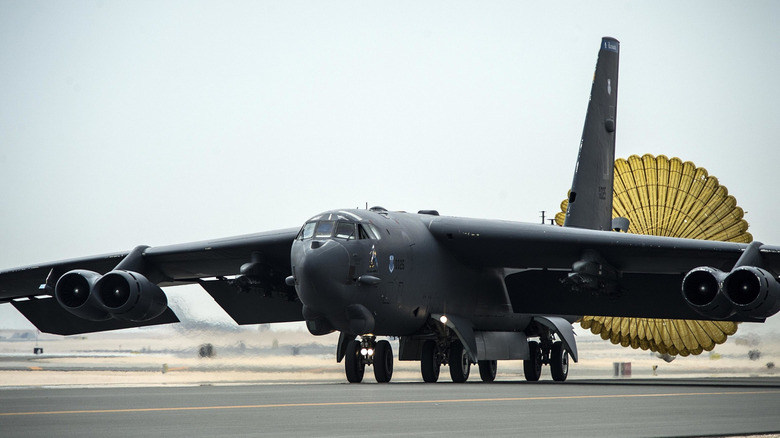How A Giant Parachute Helps The B-52 Come To A Complete Stop
At 159 feet, four inches long and a wingspan of 185 feet, the B-52 aircraft family is part of popular culture and a powerhouse worthy of the name Stratofortress. It can weigh just short of half a million pounds (488,000 lbs) at takeoff, and is still capable of a top speed of 650 mph. It's certainly not the fastest bird in the military, but to aid in landings while cutting down on particularly costly wear and maintenance, it has a little secret. Or, rather, it has a huge secret that's about 90 feet long.
As part of the overall landing process, the B-52 deploys a drogue parachute, propelled by a much smaller secondary chute that 'launches' it free. It's a similar concept to the parachutes deployed by drag racing cars, in that they're designed to create drag and bring the vehicle to a safer stop sooner. In October 2022, Aircrew Flight Equipment Senior Airman Tyler Barnes explained the huge aircraft's use of the parachute to KSLA News: "The B-52 uses it like a safety buffer. It helps slow it down."
The idea also helps prevent the brake components of the B-52 (or other aircraft that employ them) from having to work so hard. The significant weight of the aircraft translates to a lot of energy required to brake efficiently, so the parachute kicks in to help. The U.S. is still flying the B-52 family, and so it's got to treat it right.
There are some minor drawbacks to using the B-52's giant parachute
The B-52's drag parachute, in all its 200-pound glory, is packed away into what Senior Airman Tyler Barnes described to KSLA News as "that tiny little chute that looks so nice." Looking at the chute, you wouldn't quite believe that such an enormous parachute could ever be folded into something so small. According to Barnes, between two and six people would typically take part in the folding process to put it away, but a press had been arranged for the team that could make it a one-person job. It's not simply a matter of packing the parachute away and reinstalling it on the aircraft after every use, though.
Because it's an important part of the aircraft's overall performance, it too must be carefully examined for any damage, and repaired or replaced when necessary. Then there's the additional factor of any potential damage that the weather conditions could cause. Should the B-52 have to make a landing in heavy rain, there's a risk of the parachute becoming moldy. In order to prevent that, there's a painstaking process of checking for any detritus that could damage them or affect performance is needed, before the parachutes are thoroughly dried.
Andersen Air Force base in Guam has a huge parachute drying tower with a furnace to dry the within 12 to 18 hours. Without the furnace, it could take two days. And so the eight-engine B-52 continues to serve.

